Some call it a South American word. Others suggest it emerged from Spain. In either case, the term El Nino means one thing. It refers to the oscillation between hot and cold weather that leads to a certain change in atmospherics in a temperate zone.
You take the term and place it in the tumultuous world of Formula 1- a temperate zone of sorts marked by speed and grit, guts and glories, heartbreaks and triumphs, sudden collisions and shock pit stops- and you come to embrace an icon from Spain.
The 'El-Nino' of F1 moves on
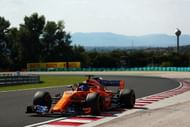
Imagine this predicament. By the end of the next quarter, Wikipedia will use the term 'former' in describing Fernando Alonso as the F1 double-world champion. For a man whose captures the stormy undercurrents of Formula 1, embodying the intense heat of competition and the painstaking triumphs, the phrase former comes to befit other drivers, but not Fernando. Isn't it?
You come to hail a man who's entered 305 Grands Prix, clinched 97 podiums, grabbed 32 race wins, enthralled fans, enjoyed worldwide attention, crushed the hearts of his opponents, lifted the spirits of his fans and above all, epitomised true grit and perseverance.
Therefore, there's a little irony that Fernando Alonso of Oviedo, Asturias, Spain is hailed as "El Nino" in Formula 1. At the same time, there's hardly a surprise that Alonso's nickname pays homage to his fiery persona that marks his hot streak of domination and his cool handling of pressure and intense situations.
Ever since 2001, when he first arrived in the sport, Fernando Alonso has stood tall to the expectations the world has had of him, from a driver known to remarkably push himself to the limit in order to extract nothing best from himself. And despite driving a barely drivable and utterly uncompetitive McLaren, probably that'll be the case when Alonso enters his final Grand Prix at Abu Dhabi, later this year, in November.
It isn't every day these days that Fernando Alonso trends on social media.
Only 126 of his fabulous 1893 career points have come since 2015 ever since he chose to sit in the McLaren starting 2015 season. There's a little wonder but an enormous pain that his retirement from the sport - with 8 more races to go - has brought him back to the top of the charts, even if this doesn't qualify as a great ranking, typical of the charts that Fernando has topped in the past.
That said, it may not be wrong to arrive at an admission.
Alonso's career can be easily split into 3 parts.
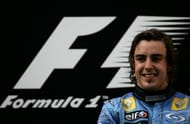
There's the triumphant Renault-era that made him a champion on not one but two occasions, the dominant Ferrari stint that made him an eternal favourite and the period of onerous trouble with McLaren, a shift that downed the game of a true warlord of Formula 1, even as Alonso himself hasn't stopped pushing.
So whether you recall the boyish Fernando from 2005 and 2006, the one who popped open the champagne beating his chest after being adjudged world champion in China and Interlagos, respectively, or the bearded man who drove past Hungaroring in 2017 setting the fastest lap in a car that seemed barely drivable - there's no denying Alonso's craft. There's no denying imperious fighting instincts that the man still possesses that have already earned him an incredible win at Le Mans on debut (with Toyota).
Minardi birthed him, Renault crowned him a champion but it was Ferrari that anointed him as a knight.
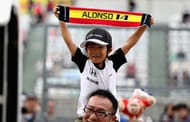
For as long as F1's globetrotting caravan continues to send fans into a tizzy, Alonso would be celebrated for manifesting his true potential as a race winner at Renault. When he entered the Australian Grand Prix of 2001 sporting short golden streaks and that puffy boyish look, few doubted his talent.
Minardi got a young Spaniard to cut his teeth in a world that was buoyed by the gusty triumphs of Schumacher and Barrichello. 2003 unlocked a long-locked dude and a would-be F1 great. At Hungaroring, he'd blast past his opponents with quintessential bravado to elope with his maiden Grand Prix win.
Chuffed and ecstatic amid 30,000 plus fans stunned to see a Renault scorch past the Ferraris and McLarens, the French team unveiled an icon in making.
The lion-heart of F1
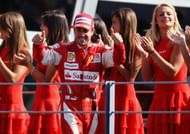
Perhaps what separates F1 drivers from other sportsmen is that they are always ready to put their lives on the line for competing amid massive contests in a contest where the stakes are incredibly high and the risks perhaps even higher.
While conjecture would do a great disservice to other drivers, it has to be said not many would have had the spine to compete in the remainder of the season, let alone a single race the way Fernando did upon his crash at the 2016 Australian Grand Prix. This was his second year at McLaren and the penultimate year of the team with Honda, its engine suppliers.
And that incredible instance, of the Spanish samurai standing back on his knees, after having somersaulted multiple times, having collided with Esteban Gutierrez, only to wave out to his fans perhaps captures the spirit of a driver who knows not the meaning of 'giving up.'
"You see the sky, you see the ground and you want to stop but you can't but you worry because your mother is watching you on television," were Alonso's thoughts as he sipped an energy drink and broke into an earnest and that very charming smile in the immediate aftermath of the heart-stopping incident.
If that's not indicative of this dogged competitor, one wonders what might?
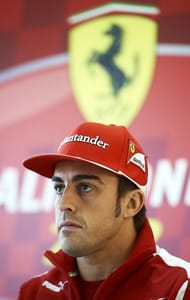
It is, therefore, utterly fair to hail Fernando Alonso as this great dogged competitor of his times, who'd stop at nothing in going the extra mile to earn himself his deserving place on the grid. And therefore, there's equally no surprise as to why both Vettel and Hamilton acknowledge and hail Fernando Alonso as among the strongest opponents they've faced on the track.
Hamilton, his teammate at McLaren starting 2007-09, would understand a thing or two of what it means to compete against a man immensely driven to excel. Picture the fight between the Mercedes and McLaren driver in the closing stages of Interlagos, 2017 where Fernando held up and nearly defied Hamilton, in a visibly-superior and undoubtedly uncollapsible car in the battle for ninth for 2 laps on the trot.
Alonso versus Vettel, the 2012-13 years
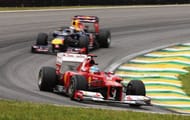
But all that told, it will be his dominant, heart-wrenching turnout with Ferrari, underlined by his epic duels with Sebastian Vettel (then, at Red Bull) that'll uphold the persona of Scuderia's knight. Just like 2005 and 2006 were years of Fernando's unprecedented dominance at Flavio Briatore-run Renault, the 2012 and 2013 seasons, in particular, were the times where the German driver enjoyed a nearly hegemonic domination over the grid.
Hamilton failed to catch up with Vettel. Kimi was no longer around. Button and Massa had no answer. There was only one man who stood up to tackle Sebastian Vettel's marauding charge with Red Bull.
In an age bolstered by excessive competition as also reviled by the excesses it imposes, modern sport, it ought to be said, triumphs when its true ambassadors excel at the highest level. And that is precisely what Fernando Alonso did in rescuing Ferrari from the onset of 2010, ever since he managed to win his maiden Grand Prix for the team at Bahrain and drenched the Tifosi in champagne, standing at the very top at Monza.
It was a moment of reprieve for a team that had endured some punishment by the likes of Red Bull and McLaren in 2008, 2009 seasons. It was a team that had been on the look-out for a firefighter who could salvage a troubled albeit legendary marquee with a second-wind. And so Alonso stepped in.
Must it be said, there may not have been a Vettel right on top had Alonso very nearly not eaten him up (or raced him down) starting 2012-13. Then whether you recall the visibly distraught spectacle of the Spaniard, standing third on the podium at Interlagos perceptibly gutted, at having realised that he'd once again lost the championship to Sebastian or the triumphant drive at Spain in 2013, where he exhibited uncontrollable appetite to win, Formula 1 for these two years became a saga of Sebastian's charge pitted against Alonso's might.
In other words, it could be said, for two, back-to-back seasons, F1 became the lair of Vettel's victorious run pegged against Alonso's valiance. Perhaps that is why even Vettel himself hailed Alonso, when the latter entered his 250th Grand Prix, asking him to return to the front of the grid and that it was a bit 'empty' without him.
Although Fernando Alonso couldn't manage to do what Kimi did - winning a championship in only the maiden season with Ferrari - he certainly lifted the mood and elevated the atmospherics of F1's grandest stable. Yet, it's completely redundant to even compare Raikkonen, in his first year of return with Scuderia, with Alonso as the latter would dismantle the 'Iceman', scoring 161 points when compared to Kimi's 55.
But even today, the echo of words like "Grande Fernando, Fantastico" reverberate in the ears of fans who've been awe-struck by Alonso's dogfights with the Red Bull. The Dark Knight didn't have to win to play to the gallery. Perhaps, he was meant to elope into thin air, but only after rescuing the people from destruction.
Only then does he truly transform into the Dark Knight Rises philosophy, isn't it?
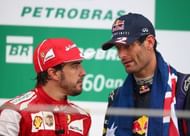
But after having seen the highs; having won 2 world crowns, garnering 43 podiums alone at the Prancing Horse against the indomitable Vettel (then at Red Bull), grabbing thumping wins everywhere whether Germany, Bahrain, Bahrain and Malaysia (3 wins at each of these circuits), Alonso would endure the worst calamity in his hitherto-triumphant career in a team that's been donned by a great like Ron Dennis.
The bitterness of being at McLaren
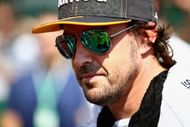
At McLaren, Alonso would earn the disappointment that perhaps now justifiably explains his eventual stand.
In the year of his return to his former team, Alonso would endure 7 DNFs. He'd be seventeenth on the driver's standings. Next year, he'd face 3 mechanical DNFs but true to his fighting style would mount a comeback and end tenth on the standings. In 2017, familiar scenes of an achingly bad 2015 would return, Alonso's dilemma exacerbated by the failure to even start the race at Sochi. In enduring 7 mechanical DNFs, the same as 2015, it was clear, there was no way that McLaren would mount a comeback.
For a man who stands seemingly true to one of Kurt Cobain's epic quotes - It's better to burn out than to fade away - there's hardly a surprise that in a withering machinery Fernando was indeed fading away.
While "El Nino" has emerged from the many turnstiles to entertain and overcome heartbreaks, trials and tribulations to demonstrate his passion in an F1 car, it's also inexplicably sad to see him leave.
But here's what we ought to remember. He's no longer the smiling, jovial, straight-talking person he seems, the one those stylish dark shades hide once he's inside the car. Then, Alonso transformers into a gladiator out to combat in a coliseum. And that will forever be the sight that'll stay embued in the hearts of those who he has touched through his incomparable style. Forza Fernando.
